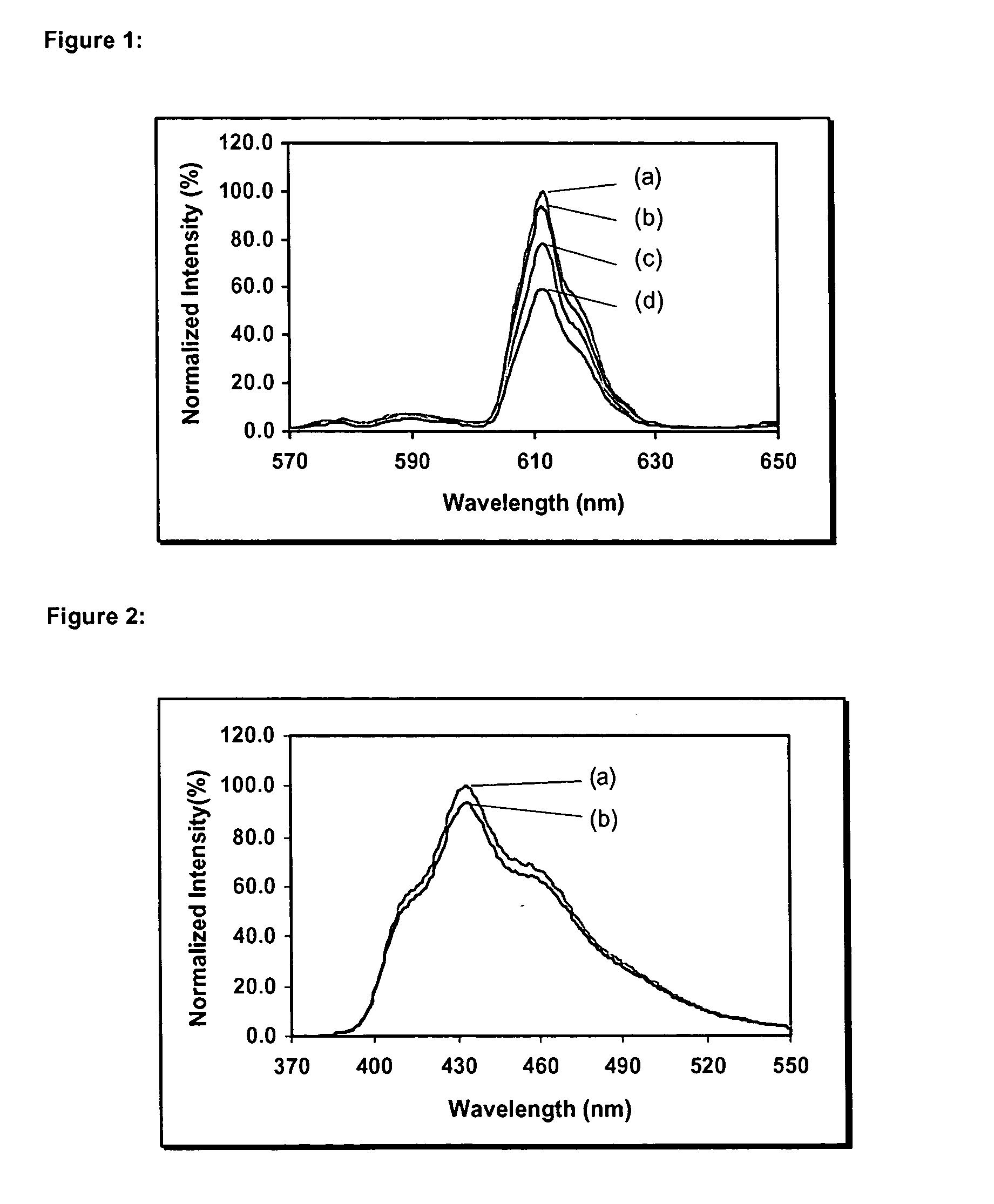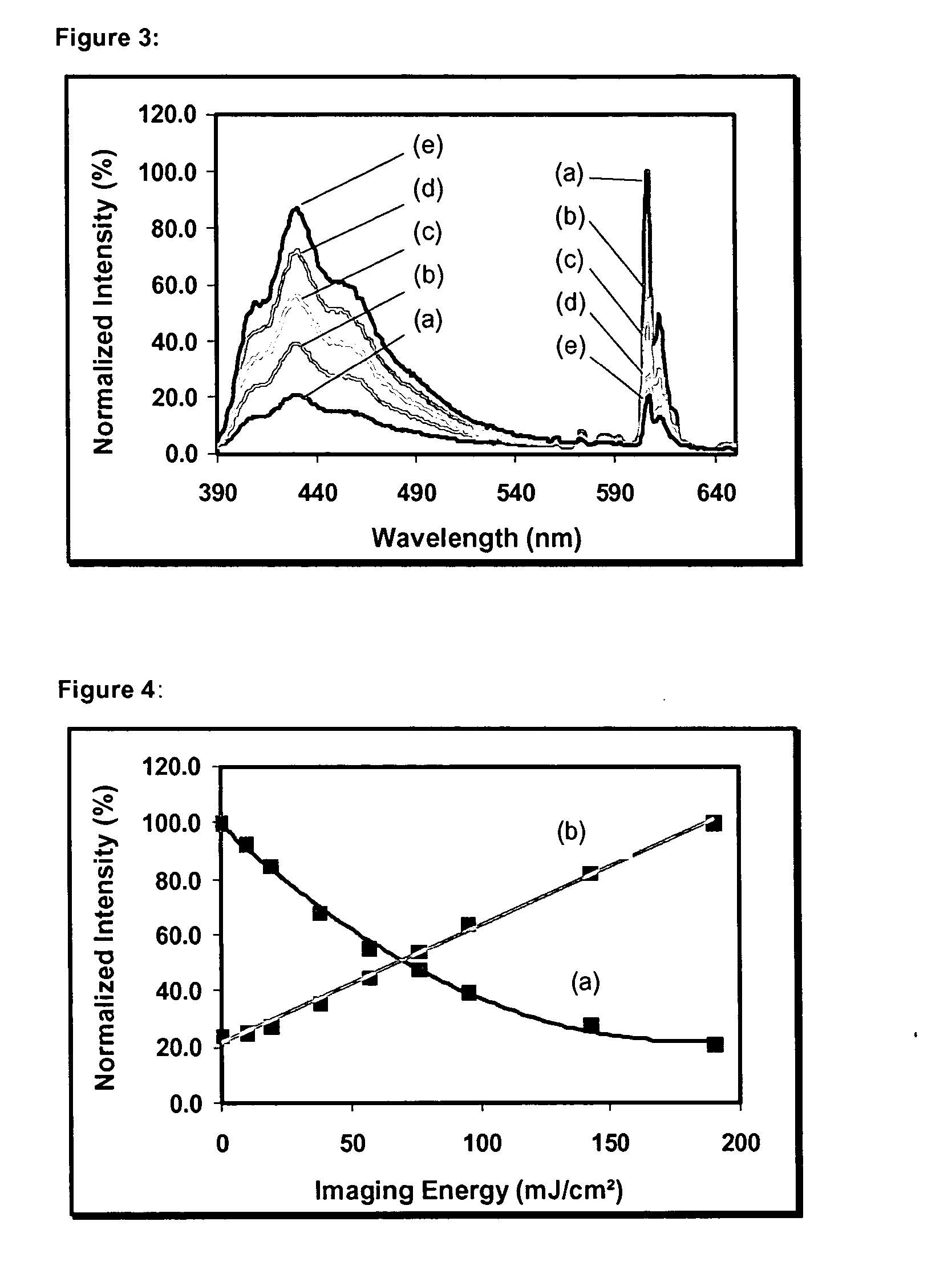Method for recording information in luminescent compositions and uses thereof in articles of manufacture
a technology of luminescent compositions and information, applied in the field of luminescent composition recording information, can solve the problem that the art fails to disclose the method of recording information in luminescent compositions
- Summary
- Abstract
- Description
- Claims
- Application Information
AI Technical Summary
Benefits of technology
Problems solved by technology
Method used
Image
Examples
example 1
[0109] One gram of tris(dibenzoylmethane)mono(phenanthroline)europium (III) (ADS051RE, available from American Dye Source, Inc.) was dissolved in 200 ml toluene solution containing 20 grams poly(methylmethacrylate) (Molecular weight 120,000, available from Sigma Aldrich). The solution was coated on Mylar film using wire-wound bar. Uniform colorless film was obtained after drying with hot air gun. When excited with ultraviolet light (i.e., 370 nm), the film emits a bright red color light and the luminescent spectrum shows the fluorescent peak at 612 nm. The film was then imaged using a triple Nd-YAG laser (355 nm, available from Spectra Physics) at different energy densities. No visual color change was observed with the naked eyes. However, upon exposure to deciphering ultraviolet light (i.e., 370 nm), the luminescent color of the image area changes gradually from red to colorless with increasing laser imaging doses. FIG. 1 shows the luminescent spectra of the image area with differe...
example 2
[0111] Five hundred milligrams (500 mg) of Uvitex OB (available from Ciba Specialty Chemicals) were dissolved in 200 ml toluene solution containing 20 grams poly(methylmethacrylate) (Molecular weight 120,000, available from Sigma Aldrich). The solution was coated on Mylar film using wire-wound bar. Uniform colorless film was obtained after drying with hot air gun. When excited with ultraviolet light (i.e., 370 nm), the film emits a bright blue color light and the luminescent spectrum shows the fluorescent peak at 430 nm. The film was then imaged using a triple Nd-YAG laser (355 nm) at different energy densities. No visual color change was observed with the naked eyes. Upon exposure to deciphering ultraviolet light (i.e., 370 nm), the luminescent color of the image area was almost unchanged even after laser imaging with 190 mJ / cm2, as shown in FIG. 2.
[0112] This example shows that the fluorescent peak of Uvitex OB as the only luminescent compound in coating loses only a few percent ...
example 3
[0113] Five hundred milligrams of tris(dibenzoylmethane)mono(phenanthroline)-europium (III) (ADS051RE, available from American Dye Source, Inc.) and six hundred milligrams of Uvitex OB (available from Ciba Specialty Chemicals) were dissolved in 200 ml toluene solution containing 20 grams poly(methylmethacrylate) (Molecular weight 120,000, available from Sigma Aldrich). The solution was coated on Mylar film using wire-wound bar. Uniform colorless film was obtained after drying with hot air gun. When excited with ultraviolet light (i.e., 370 nm), the film emits a bright red color light and the luminescent spectrum shows two emission peaks at 430 nm and 612 nm. The former luminescent emission peak is the fluorescent characteristic of Uvitex OB, while the later is the fluorescent peak of ADS051RE, respectively. The film was then imaged using a triple Nd-YAG laser (355 nm) at different energy densities. No visual color change was observed with the naked eyes. However, upon exposure to de...
PUM
| Property | Measurement | Unit |
|---|---|---|
| emission wavelengths | aaaaa | aaaaa |
| emission wavelengths | aaaaa | aaaaa |
| emission wavelengths | aaaaa | aaaaa |
Abstract
Description
Claims
Application Information
 Login to View More
Login to View More - R&D
- Intellectual Property
- Life Sciences
- Materials
- Tech Scout
- Unparalleled Data Quality
- Higher Quality Content
- 60% Fewer Hallucinations
Browse by: Latest US Patents, China's latest patents, Technical Efficacy Thesaurus, Application Domain, Technology Topic, Popular Technical Reports.
© 2025 PatSnap. All rights reserved.Legal|Privacy policy|Modern Slavery Act Transparency Statement|Sitemap|About US| Contact US: help@patsnap.com



